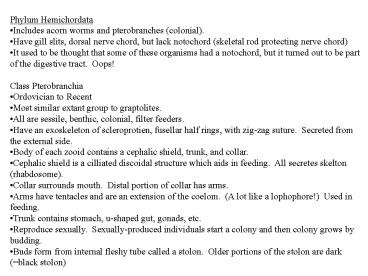Phylum Hemichordata - PowerPoint PPT Presentation
1 / 4
Title:
Phylum Hemichordata
Description:
Most similar extant group to graptolites. All are sessile, benthic, colonial, filter feeders. ... Bushy, benthic, sessile (Dictyonmena = epiplanktonic? ... – PowerPoint PPT presentation
Number of Views:3261
Avg rating:3.0/5.0
Title: Phylum Hemichordata
1
- Phylum Hemichordata
- Includes acorn worms and pterobranches
(colonial). - Have gill slits, dorsal nerve chord, but lack
notochord (skeletal rod protecting nerve chord) - It used to be thought that some of these
organisms had a notochord, but it turned out to
be part of the digestive tract. Oops! - Class Pterobranchia
- Ordovician to Recent
- Most similar extant group to graptolites.
- All are sessile, benthic, colonial, filter
feeders. - Have an exoskeleton of scleroprotien, fusellar
half rings, with zig-zag suture. Secreted from
the external side. - Body of each zooid contains a cephalic shield,
trunk, and collar. - Cephalic shield is a cilliated discoidal
structure which aids in feeding. All secretes
skelton (rhabdosome). - Collar surrounds mouth. Distal portion of collar
has arms. - Arms have tentacles and are an extension of the
coelom. (A lot like a lophophore!) Used in
feeding. - Trunk contains stomach, u-shaped gut, gonads,
etc. - Reproduce sexually. Sexually-produced
individuals start a colony and then colony grows
by budding. - Buds form from internal fleshy tube called a
stolon. Older portions of the stolon are dark
(black stolon)
2
- Class Graptolithina
- Important index fossils for Ordovician and
Silurian. Range from Cambrian to Pennsylvanian. - All colonial. There are bushy forms, sheet like
forms, and rod-like forms. - Skeleton composed of tough scleroprotien. Made
of two layers - Fusellar half rings with zig-zag suture
- Cortical layer (like a wrapped sheet).
- Fusellar layer (inner) secreted first, then
cortical layer. Must have had external
secretion. - Organic, so preserve best in anoxic substrate.
Black shale graptolite biofacies. - Best preserved specimens are from limestone.
Collected by dissolving limestones. - Graptolite colony rhabdosome
- Initial individual that starts colony sicula
- Aperture typically points opposite direction of
other zooids. - Sexually produced? (ancestrula-like?)
- Underwent metamorphism different skeletal
structure in pro- and metasicula - Close to sicula proximal. Away from sicula
distal - Individuals in colony thecae. Theca size and
shape change through astogeny. - Arrangement of theca, thecal shape, and aperture
shape are important in classification. - Each linear branch of thecae is called a stipe.
- A thin tube (nema) extends from the apex of the
sicula. Called a virgula if it contacts theca.
3
- Orders of Graptolites
- Order Dendroidea
- Middle Cambrian to Early Pennsylvanian
- Bushy, benthic, sessile (Dictyonmena
epiplanktonic?) - Formed golf ball size to grapefruit size colonies
- Stipes often connected by dissepiments
- Two distinct types of theca autotheca and
bitheca. - Colony attached to seafloor by stem-like
extension of sicular aperture. - Tolerant of low O2? Preservational bias?
- Most are bradytelic at generic level, but some
species are important for biostratigraphy. - Order Camaroidea
- Encrusters
- Densly packed auto- and bitheca. Autotheca look
like headless geese (to me, at least) - Late Cambrian to Early Ordovician (glacial
erratics from Poland, mostly) - Order Crostoidea
- Encrusters.
- Sparselly packed auto- and bitheca. Authothecae
are vase-like with constricted apertural neck.
4
- Order Graptoloidea
- Early Ordovician to Early Devonian
- Super index fossil
- Few stipes
- Shapes
- Pendant (theca face in, aperture of theca and
sicula face same direction) - Horizontal
- Reclined (theca face out, apertures of theca and
sicula face opposite directions) - Scandent
- Uniserial or biserial
- Planktonic
- Some with floats
- Spines and lightweight skeleton may have aided in
floatation - Coiling forms may have spiraled up or down in
water column - Mass blooms and die-offs.
- Graptolids through time
- Early Ordovician Multiple stipes, dichotomously
branching, leafy phyllograptids (4 stipes) - Early to Middle Ordovician Pendant graptolites
- Middle Ordovician tuning fork graptolites
(biserial to uniserial stipes

